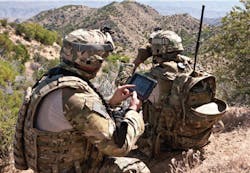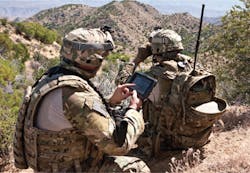Special Operations forces eye new lightweight SATCOM communications
MacDILL AIR FORCE BASE, Fla. - U.S. Special Operations Command (SOCOM) is kicking off an industry competition to develop a new family of lightweight satellite communications (SATCOM) equipment for covert use on the battlefield.
SOCOM officials, based at MacDill Air Force Base, Fla., have announced plans to issue a solicitation later this year for the SDN Family of Systems (FoS) Sub One-Meter Variant (SDN-Lite) project.
The future SDN-Lite terminal variants will operate in X, Ku, and Ka SATCOM bands, and will be part of the SDN family of systems, which will represent an evolutionary follow-on replacement for the legacy Special Operations Deployable Node-Family of Terminals (SDN-FoT).
The SDN-Lite will be a sub one-meter aperture terminal for U.S. Special Operations Forces (SOF) that will consist of modular and portable SATCOM terminal variants that will handle secure and non-secure voice, video, and data communications at several classification levels.
The SDN-Lite will provide multi-user, multi-classification SATCOM transmit and receive capabilities, and provide Special Operations users with worldwide connectivity to the SOF Information Environment (SIE) via separately acquired baseband equipment.
The primary goal of the SDN-Lite is to deliver at least the existing capabilities of legacy Special Operations SATCOM systems while reducing size, weight and power consumption (SWaP).
The SDN family of terminals is an evolutionary, follow-on life cycle replacement for the legacy SOF Deployable Node-Family of Terminals (SDN-FoT).
The legacy SDN-FoT comprised the SDN-Lite, SDN-Medium, and the larger SDN-Heavy terminals. The FoS ultimately will comprise several terminal variants: a sub one-meter aperture terminal operating in the X, Ku, and Ka frequency bands (SDN-Lite), a terminal in the range of 1.2-to-1.3-meter aperture with automatic satellite acquisition operating in the X, Ku, and Ka bands (SDN-Medium), and a 2-to-2.4-meter aperture with automatic satellite acquisition and tracking, operating in the C, X, Ku, and Ka bands (SDN-Heavy).
SOF historically operates in environments with limited or no command, control, communications, computers, intelligence, surveillance, and reconnaissance (C4ISR) infrastructure, which necessitates reliance on portable equipment that warfighters carry forward for initial command and control.
The first phase of SDN-Lite production will build and test five each of the X-band SDN-Lite and two each of the Ku and Ka-band SDN-Lite. U.S. Special Operations is pursuing the SDN-Lite project as a non-developmental effort, so system performance for the most part reflects the capabilities of the currently fielded legacy systems.
The contractor ultimately chosen for the SDN-Lite project should be able to deliver the first nine terminals within 90 days of contract award, which is expected in November 2017. The winning SDN-Lite contractor should be able to deliver at least 15 SDN-Lite terminals each month until the five-year program concludes at 809 terminals.
Special Operations Command officials say they anticipate a formal solicitation for the SDN-Lite project sometime this fall. Companies interested should e-mail questions and comments to the Special Operations Command's Jonathan Katz at [email protected] and Phillip Sabo at [email protected].
More information is online at www.fbo.gov/spg/ODA/USSOCOM/SOAL-KB/H92222-17-R-0004-SDN-L/listing.html.

